Introduction
Scratchmill Scar is a typical 1960s upland conifer plantation. Established on a sandstone hillside with typical lowland heath characteristics, the site is dominated by even aged conifer stands well suited to the soils; principally Scots pine (Pinus Sylvestris), Japanese Larch (Larix Kaempferi) and smaller proportions of Sitka Spruce (Picea Sitchensis) and Lodgepole Pine (Pinus Contorta) on the wetter soils.
With a history of traditional management including regular thinning from an early age, Scratchmill Scar has a relatively windfirm crop of even-aged, quality timber. Well situated to take advantage of road links to the borders and large-scale processors, this is a commercial plantation with plenty of potential.
In addition to its economic potential, Scratchmill Scar is also particularly promising from an ecological point of view. With an established Red squirrel population, badgers, foxes, bats and an impressive range of bird species, there are significant opportunities to capitalise on the existing biodiversity of this woodland. This ecological potential is further enhanced by the proximity of SSSI lowland Heath on the North East boundary of the woodland.
Despite its potential, as with most woodland, Scratchmill Scar also has several challenges which range from tree diseases, invasive species and browsing pressure, to the need to conserve native red squirrels and protect ground water quality. In a changing climate, with predicted increases in storms and periods of drought, the relatively simple age class structure and narrow diversity of species also present challenges.
This case study summarises the approach taken by the landowners and manager to realise the set objectives for this woodland, whilst ensuring the future resilience and ecological function of the woodland. Though early in it’s transformation under new management, the thought process, planning, and lessons learnt so far will hopefully inspire other landowners with similar challenges.
- Property Name- Scratchmill Scar
- Location- Penrith, Cumbria
- Area- 89 Hectares
- Species- JL, SP, LP, SS
- Age- Av. 56
Ownership and Objectives
Bought in 2023 by the current owners as an investment; the woodland had an existing FC approved management plan. This extant plan was developed around a standard approach of gradual clearfelling and restocking of the currently even aged woodland, with economic appraisal based on estimates from timber markets at their peak just after covid. The agent John Lees was asked to undertake a review of the management plan after purchase to ensure the plan delivered the new owners’ objectives for the site.
These objectives are:
- To cover costs
- Accumulate Value
- Enhance Wildlife Value
Woodland Overview
Soils:
Scratchmill Scar geology is predominantly Penrith Sandstone Formation comprising coarse grained materials and thus soils are generally podzolic. Owing to the variation of terrain from steep slopes to flat plateaus, there is variation in soils across the site, with some areas being wetter and gleyed in contrast to the predominantly free draining soils.
Soil depth also varies across site with bedrock being quite close to the surface in areas.
Soil Survey:
Soil sample from sub compartment 1D
Soil sample from sub compartment 2A
Soil sample locations across the sub compartments
Species Composition and Stocking
Scratchmill Scar is dominated by Scots pine, but with a significant proportion of larch. Smaller areas of Sitka spruce and Lodgepole pine are found in the wetter areas and have experienced some windblow. Generally, historic planting has matched species well to soils, and despite some evidence of needle blight in the pine, trees appear healthy and of moderate to good form.
Most stands have been thinned in the past, though thinning intensity has varied, with some areas developing a more patchy nature. Crop details have been summarised in the table below.
Example of the variable stocking of stands with some open areas.
Digital surface model of sub-compartments at Scratchmill showing variation in stocking
Biodiversity
EPS Survey and Species of Interest:
In the interests of security, the distribution and location of identified species and features of ecological interest have not been shown in map form here. However, point locations of dreys, nests and other features are quite evenly distributed across the woodland block and as such, all areas in which work was undertaken required operations to be planned around these features.
Red Squirrels
As part of a larger, contiguous block of coniferous forestry (under different ownerships) Scratchmill scar is within a red Squirrel conservation area and provides an important habitat for the species. Red squirrels have been seen regularly on site, and dreys are present within the woodland. Given the pressure from grey squirrels in the surrounding landscape, maintaining suitable habitat and minimising disturbance for Red Squirrels is an important consideration.
Raptors
Sparrow Hawks were identified as being present onsite, both through activity and potential nest site. Locations of the nest site were noted, and buffer zones were applied to ensure protection of the nest and avoid disturbance.
Badgers
Badger sets were identified onsite and active. Marked, with buffer zones applied.
Birds
The woodland has had several bird species of interest beyond the more common species, including crossbills, woodpeckers and bullfinch.
Butterflies and Moths
Though not surveyed in detail, open ground around the woodland rides, open space/rough ground around the onsite quarries and in places the higher light levels resulting from well-thinned stands support a noticeable abundance of butterflies and moths.
Deer
Scratchmill Scar, as part of a larger, contiguous block of plantation and woodland, holds a stable population of Roe Deer, but no other species have been identified in the area. This part of Cumbria is only likely to hold the native Roe and Red. Damage is visible on site, however, the presence of substantial natural regeneration across the site suggests that the population is manageable.
Example of deer browsing on some regeneration and understory.
Archaeology and Quarrying
The woodland prior to afforestation has a history of quarrying. Old quarry holes are distributed across the site, creating some obstacles for harvesting and machinery access. The site also contains a large active quarry with access to the public road.
The image below uses a digital terrain model to illustrate the distribution of old quarry workings (these look like craters on the map), as well as showing the rocky outcrop and steep ground towards the south west quarter of the block.
Associated with the previous land use are several archaeological features, which include the base of old site buildings and accommodation. These features are not obvious amongst the bracken and need to be clearly marked to avoid disturbance during any harvesting operations.
Constraints map showing position of the steep ground and rocky outcrop to the south west quarter of the block and distribution of old quarry workings
Plant Health
Overall, the woodland has two principal plant health threats. Firstly, Phytophthora ramorum is a significant threat to larch within the county, with areas of west Cumbria significantly impacted by outbreaks of the disease. With a significant proportion of larch within the woodland, this could be a concern. However, outbreaks of the disease have so far been confined to the wetter, western coast of the county, and the drier eastern side of the county in which Scratchmill Scar is located has remained largely unaffected by the disease.
More of a current concern is the presence of Dothistroma septosporum (Red Band Needle Blight) in some of the pine within the woodland. Though not extensive and largely found in the more dense, less well-thinned stands of pine, its presence is of concern.
Needle blight in pine
Roads and Access
Scratchmill Scar is well served with metalled access to the public highway, and a circular main ride (only suited to 4x4 and machinery use) which gives access around the whole woodland. Taking advantage of the onsite quarry, significant road upgrades were undertaken to the main haulage route from the public highway up to a turning and stacking area near the quarry before harvesting work commenced.
Road upgrades to the main haulage route
Unimproved section of woodland ride
Opportunities and Challenges at Scratchmill Scar
Based on the woodland survey, there are a number of challenges and opportunities for Scratchmill Scar, which the woodland management plan considers. The following is a summary of the key points:
Opportunities:
- Significant areas of advanced natural regeneration suggest potential for further use of natural regeneration as part of the silvicultural prescription for the woodland.
- Soils across the woodland are generally favourable for most principal productive species (See Esc Reports in appendix), presenting options for future species choice.
- The quality of timber across the site is generally good and will be easy to market.
- The existing access network provides a sound basis for management and harvesting.
- Previous thinning at variable intensities has provided the opportunity to expose the stands within the woodland to wind. However, there are no current signs of wind damage beyond the small area of spruce. This would imply good stability for future thinning.
- On-site quarry provides an affordable option for improving access and infrastructure within the woodland as required.
- A healthy population of red squirrels suggests a promising future for the species in this woodland if appropriate management is undertaken.
- Deer browsing is sufficiently low to allow natural regeneration to establish successfully, which should make future population management more achievable.
Challenges:
- Low species diversity within the woodland is a potential risk, especially with known plant health issues for the two primary species.
- Scratchmill is predominantly single age.
- Though soils at Scratchmill are generally quite favourable, they are sandy, and this area in the county can be quite dry and cold. Experience suggests that establishment in this area can be heavily impacted by protracted periods of dry weather, late frosts and drying winds.
- Plant health issues in the form of needle blight are already within the woodland and are likely to affect the overall yield of the pine over time.
- Though currently windfirm, DAMS is flagged as a limiting factor for many potential future species for the site and on an exposed upland site, wind risk can not be underestimated as a future risk.
- Extensive regeneration requires robust deer management across the whole area; fencing, etc, is not a viable option.
- Some areas in the south west of the woodland are too steep for wheeled machinery to operate, making thinning challenging.
- The presence of old quarry workings makes consistent thinning intensity and planned extraction routes difficult.
- Grey squirrels are present in the locality, and maintaining the population of reds within the woodland will require active management to keep the grey squirrels from establishing in the woodland.
Extensive larch regeneration
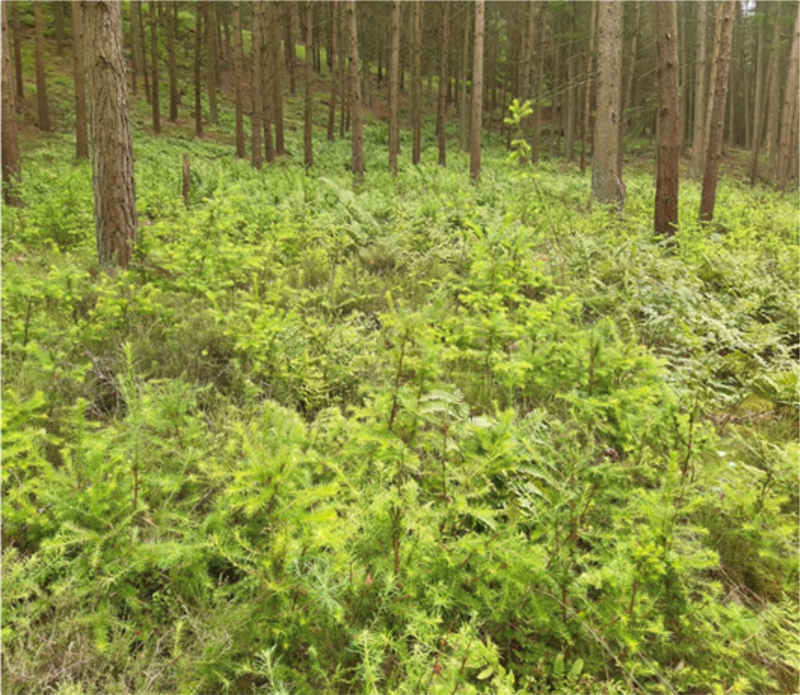
Management Options
Subsequent to a thorough site survey and assessment of the woodland options in the context of the woodland owner's objectives, three main management options were presented to the landowner.
Option 1: Clear Fell
Fell in three phases over a total area of 60 hectares, retaining 11ha adjacent to the lowland heath and 3.15 ha of checked and 11ha of poor growth mixed conifer on the peaty/ gleyed areas. The quarry area would also be left as it is.
Through restocking, this would create approximately 55 ha of mixed productive conifer and 4 ha of mixed broadleaves, with the remaining area as open ground.
The clear fell approach would be likely to lose WD2 (management) and WS1 (deer) & 3 (squirrel) funding as the habitat is altered and targets to improve conditions suitable would be difficult to argue. In this instance, a stand-alone felling licence would be applied for as required.
Owing to the need to restock, this option would require intensive ground preparation to ensure successful establishment. Furthermore, risks from weevils, strong weed growth and the ongoing need to beat up would be required. Restocking at this scale on what is a relatively exposed location would also increase the risk from frost and drought, and may limit future species options.
Through making significant holes within the woodland through clear-felling, less windfirm brown edges would be created in the woodland and expose the woodland to a higher risk of wind throw in the remaining crops.
Finally, this approach will front-load the economic return from the woodland with a significant period with no income generation.
Option 2: LISS with support from CS Resilience Option
Regenerative felling (with one 3.76ha clearfell on the steep ground adjacent to the neighbouring farm buildings). A shelterwood system would be established across the remaining woodland, with opportunities for underplanting or planting up gaps taken as appropriate. Thinning would aim to reduce basal area (gradually) to a level which will support natural regeneration and allow underplanting.
This approach will allow the introduction of a greater diversity of species, with some potentially much higher-yielding productive species being introduced. This would allow gradual removal of the existing overstory (producing a regular cash flow) whilst simultaneously increasing the overall yield of the woodland.
Thinning the pine and regular interventions should also reduce the intensity of the needle blight infection onsite and provide the opportunity to remove infected trees as they occur.
An initial thinning and clear-fell would be undertaken in the first year, with a subsequent programme of underplanting/ gap planting and restocking of around 7ha. Future interventions would take place every 6-8 years, depending on crown development and the response of natural regeneration.
This option will allow the development of a more species and age-diverse woodland with regular income. It would also enable the planting of high-yielding but softer, less exposure-tolerant productive species. Increasing reliance on natural regeneration will reduce the cost/ need for intensive ground preparation, weevil and weed management.
In addition, the maintenance of habitat connectivity and suitability for red squirrels is an important advantage.
This approach will also allow some flexibility in dealing with both future wind damage (any gaps created by windblow can be incorporated into the system) whilst minimising future wind risk through avoiding brown edges and sudden exposure to the wind.
However, this approach is not without it’s challenges. Conversion to CCF at this late stage does present challenges. Increasing risk of windblow is one significant challenge. Additionally, to ensure continued regeneration/ development of a second rotation, continued underplanting is likely to be required to supplement natural regeneration and introduce desirable productive species.
The risk from Phytophthora ramorum will also remain. As significant natural regeneration of the larch has already been established, how this risk is minimised through underplanting of alternative species will need to be considered.
Finally, owing to the responsive nature of thinning to promote stand development, predicting future thinning volumes will be difficult, and some variability should be anticipated.
Option 3: CCF without support from the CS Resilience Option
Option 3 is essentially the same as option 2, but would not take advantage of the CS resilience option. Implications of this approach may involve less time available for marking and mensuration with greater reliance on operator-select felling. This would also make operations more sensitive to timber markets, though figures used in the forecasts for these options are conservative.
Economic Appraisal
Underpinning all three options for future management is an economic forecast. The table below shows a summary comparison of “income” for the three options presented.
Total Property Income/ Expenditure per year for 7-year forecast on

Recommendations
Based on the landowner's objectives of:
- To cover costs
- Accumulate Value
- Enhance Wildlife Value
The recommendation made to the landowner was to pursue option 2. This option generates a positive cash flow across all years (covering costs) whilst accumulating value through maintaining standing timber, whilst developing an understory of high-yielding productive species. Crucially, this approach also maintains and enhances the biodiversity and wildlife value of the woodland through connectivity with the neighbouring SSI, increased structural diversity and maintaining suitable habitat for red squirrels.
The landowner agreed to go forward with option 2.
Silvicultural Prescriptions
Compartment 1
Sub Comp 1a:
This sub-compartment is on steep ground bordering an adjacent farm yard with cattle-rearing buildings. In discussion with the farmer, this site was clear felled to allow the woodland boundary to brought away from the buildings, with native broadleaves and scrub being the future species mix immediately bordering the buildings. Owing to the steep nature of the site, the majority of the site had to be felled and extracted using manual felling and extraction by an excavator based high lead. Clear felling made this operation far more economically viable.
Sub Comp 1b:
This stand was thinned where wheeled access was possible, areas around the rocky outcrop/ steep ground were avoided, with the future intention being to introduce a strip shelterwood system here which would allow working via high lead. The rest of the sub-compartment will be managed as a shelterwood with underplanting being used principally to regenerate the stand. Thinning intensity was based on evening the previously uneven thinning to allow light levels across the stand, which would support underplanting.
Underplanting of this stand will be with a mix of conifers consisting principally of 47% Douglas fir, 27% Norway spruce, and 16 % Sitka spruce. The Sitka will be planted around extraction routes so that in future thinnings high quality spruce brash will be available for thatching the extraction routes.
In addition to the overall underplanting, a species trial (adjacent to the main extraction route for ease of access) will be created consisting of Pacific silver fir, Western hemlock, Western red cedar and Japanese Red Cedar. These species, if successful will offer a useful shade-tolerant component to a future CCF system.
Sub Comp 1c:
This stand borders the SSSI restored heathland to the north-east side of the woodland. To maximise the opportunity for habitat continuity, this sub compartment will be managed on a shelterwood basis with a focus on increasing light levels to allow the establishment of more native species. This will include some group felling and maintaining a higher proportion of open ground (around 50%). Underplanting will consist of a mix of the two native oaks, downy birch and silver birch as well as a small proportion of Scots pine.
Sub Comp 1 d:
This sub compartment contains a mix of species, with the pine and larch being treat under a shelterwood system like similar areas across the woodland. However, there is an area of historical windblow in the spruce and this is regenerating vigorously. To take advantage of this potential, the spruce in this area will be managed more a as a group/ strip shelterwood with areas of regeneration being opened out to allow further regeneration to be recruited.
Underplanting across this site will consist of 47% Douglas fir, 27% Norway spruce, and 16% Sitka spruce. Again, Sitka spruce will be planted around extraction routes to facilitate good extraction route maintenance in the future.
Sub Comp 1e:
With larger areas of existing open ground, protected ecological and archaeological features, this stand will be managed under a shelterwood system as with other stands, but will retain a higher percentage of open space around protected features. Future underplanting and restocking is tbc.
Sub Comp 2a:
This sub compartment will be managed under a shelterwood system, with a regeneration felling taking place within the first year. This felling will aim to reduce the basal area down from 22- 24 to around 5- 10.
Restocking/ underplanting will be 65% Sitka spruce and 25% Douglas fir.
Sub comp 3 a:
Previously this stand has been heavily thinned. Where light levels allow, this stand has prolific natural regeneration of the larch overstory. The stand will continue to be worked on a shelterwood system. BA sweeps identified that natural regeneration seems to begin around a basal area of 24, but owing to inconsistent thinning in the past some areas are as high as BA 40. Thinning will aim to reduce BA to 22- 24 across the stand to allow initiation of regeneration with future management focused around maintaining vigorous growth of regeneration.
To add diversity to this stand and ensure that areas with poor regeneration are fully stocked and productive, underplanting will take place in the ratio of 47% Douglas fir, 27% Norway spruce, 16% Sitka spruce.
Compartment 4:
Compartment 4 is a mix of Sitka spruce and Lodgepole pine, which has seen significant previous windblow and is now regenerating prolifically. As with the spruce areas within 1d, this regeneration will be encouraged and a strip or group system will be used to gradually remove the overstory.
Theory Into Practice – Implementing the Plan
Infrastructure, Access and Harvesting
Central to the successful, sensitive and low-impact harvesting required to achieve the silvicultural objectives of the management plan is robust, well planned infrastructure. As already discussed, the first stage of improvement was to upgrade the forest road from the public road to the quarry to provide easy wagon access and turning with space provided for stacking areas both along the roadside and at the quarry turning area. This work commenced June 2024.
To reduce travelling time for the forwarder and constrain ground damage and compaction to a limited area, a new main extraction route was marked out which divides the distance between the existing circular forest ride. During harvesting, weak spots on this main route were reinforced with stone from the onsite quarry and additional brash brought from completed racks.
Main extraction route during harvesting
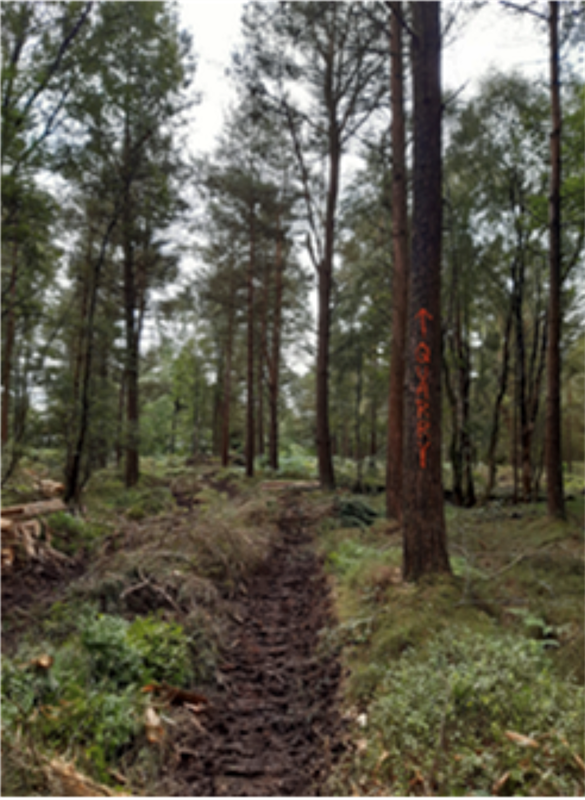
In addition to this central route, a network of permanent extraction racks were identified and marked by the forester leading away from the main rides. These permanent extraction routes allow the concentration of damage into a small area, leaving the area between routes clear from compaction and damage and allowing regeneration or underplanting to take place. Over time, as thinning progresses and overstory density reduces, some intermediate racks may be dropped.
Communicating the importance of these racks to the machine operators is crucial and in addition to marking racks from the side of the ride, the forester walked the extraction routes with the contractor at the pre-commencement meeting and at intervals as work progressed. A detailed map showing intended routes and known features was produced for the contractor and referred to in site meetings.
One challenge experienced with access during harvesting was the presence of old quarry workings and buffer zones, ecological and archaeological features. The combination of these features has meant that in some areas thinning intensity was not consistent.
Buffer zones marked around archaeology

Pre-harvesting plan of operations showing main extraction routes and intended direction for machine movements.

Permanent extraction rack
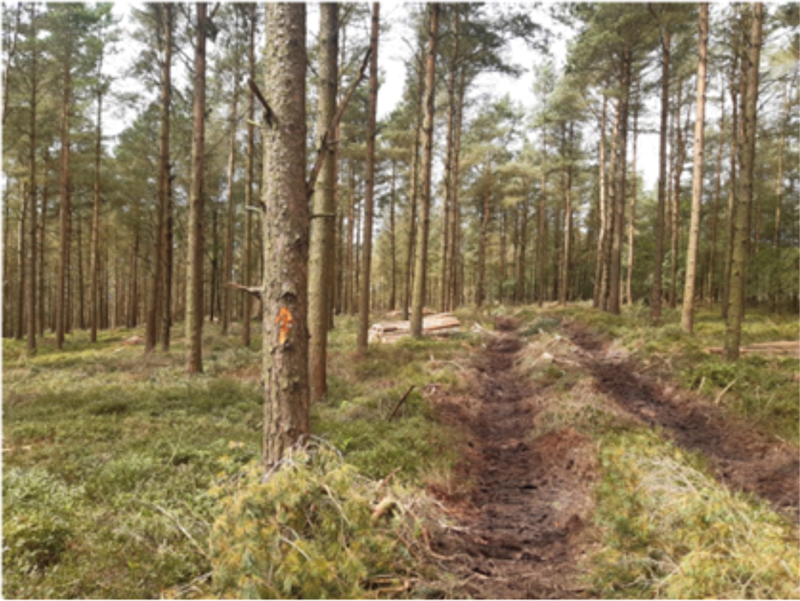
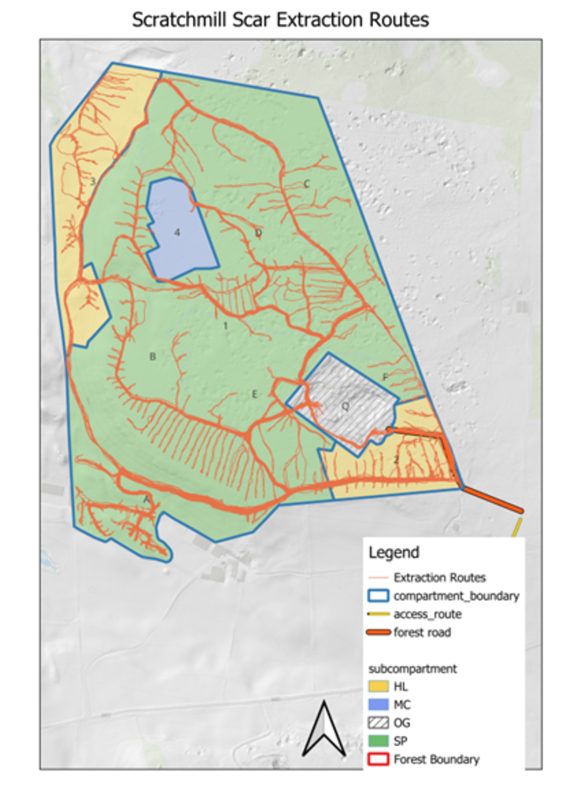
Thinning Control
Critical to ensuring harvesting meets the needs of the silvicultural prescriptions of the site is hitting an appropriate thinning intensity. Thinning specifications were based on inventory data collected as part of the management planning process and subsequent relascope sweeps to identify target basal areas associated with the initiation of natural regeneration.
Owing to the variable density of the stands at Scratchmill (a result of historical thinning) this was a task that involved careful communication between the harvester operator and manager. Thinning prescriptions for the stands varied, but in principle, there were three main factors to be taken into account:
- Target basal area
- Removal of diseased or damaged trees
- Visual adjustments to release localised regeneration and avoid buffer zones.
Target basal area was measured using relascope sweeps as work progressed and adjustments suggested to the harvester operator. In some areas example marking was undertaken to enable the harvesting contractor to get a feel for the specification. However, fully marking the site in advance of harvesting would have been prohibitively costly without additional support.
Recording Basal areas throughout the larch stands to aid visualisation of thinning intensity.
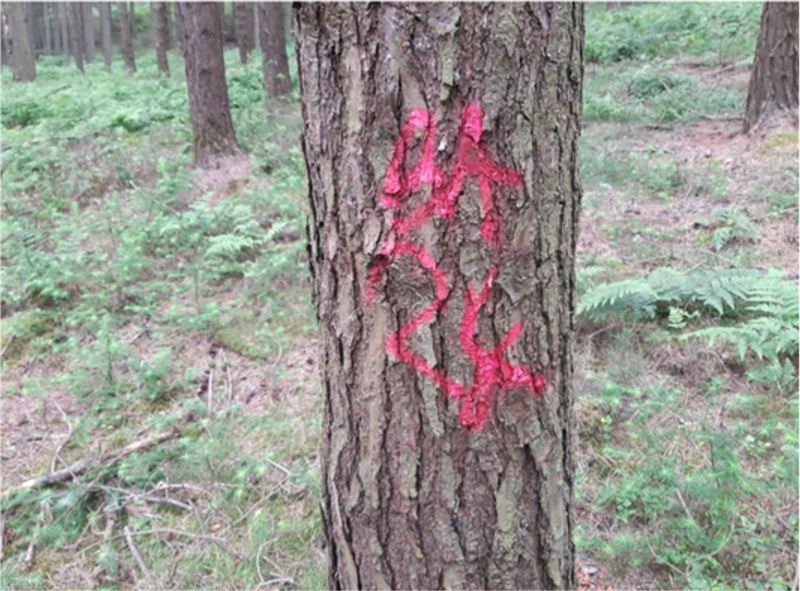
Steep Ground and Route Selection
Steep ground is a feature of the south-western side of the woodland. The most economically viable method for harvesting all areas is with a harvester and forwarder and as such the machine operators endeavoured to pick routes through the stands which allowed maximum reach into the surrounding stands and avoid the need for motor manual felling. However, some areas were too steep. The clear fell in sub comp 1a was felled using a high lead and motor manual felling. A proportion of sub comp 1 b was also too steep for wheeled machinery. The decision was made that in order to complete work to desired timelines and minimise the costs of harvesting in this first year, that this area of steep ground would be worked during the next thinning, using a high lead system to strip fell and develop a strip shelterwood system.
Thinning larch on steep ground.
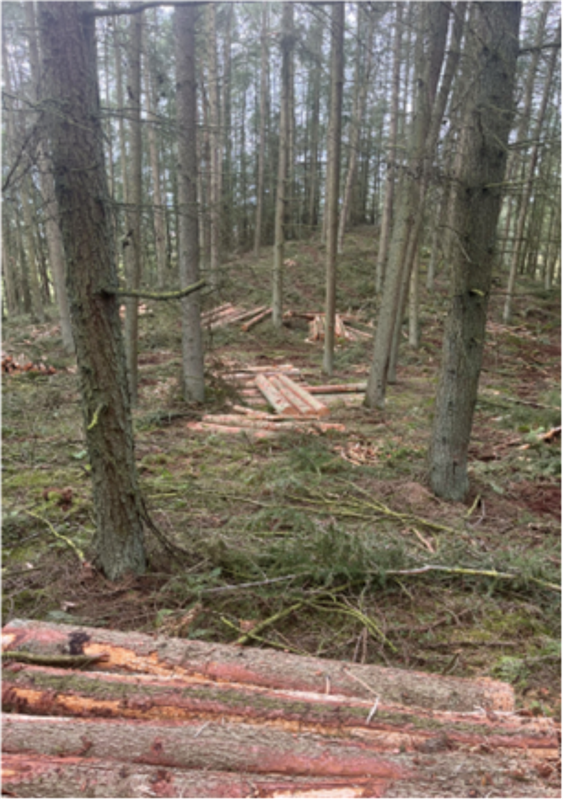
High Lead extraction from the clearfell.
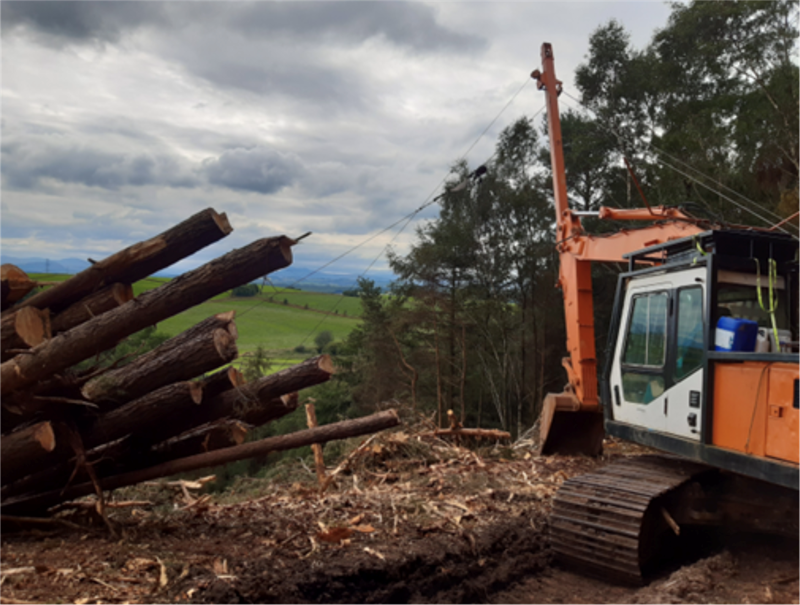
Harvesting Costs and Returns
Harvesting undertaken over the summer of 2024 achieved a good return against predicted income despite the cost of high lead extraction. In total, 3160 tonnes were removed from the harvesting works, with 840 from the clearfell and 2320 from thinning.

Ground Preparation and Underplanting
Though natural regeneration is being encouraged across the woodland, underplanting/ restocking is the principal means of regenerating the productive areas of the woodland. Underplanting allows control over species choice, the opportunity to place species where they may be of most utility (e.g. spruce near to extraction routes) and increase the overall productivity of the woodland.
Competition from weeds is likely to be a significant challenge across the woodland, and owing to the need for potential beat ups to achieve the desired future restocking, the decision was made to undertake ground preparation in the form of inverted mounding and machine screefing. This approach was justified on the following basis:
- Creates a weed-free planting position
- Allows harvesting residues to be moved by the excavator to establish even spacing (especially important where extraction routes are being planted).
- Creates easily identifiable planting locations for contractors and future beat up surveys and weeding
- Minimises soil disturbance in comparison to approaches such as trench mounding.
- Will not interfere with future thinning operations and machine access as would be the case with trench mounding
- Allows the majority of ground vegetation to be maintained, unlike operations such as mulching.
- A cost-effective method which utilises the machinery of main contractor, who also undertook harvesting work.
Excavator invert mounding and screefing.

Planting of Western Red cedar on an inverted mound.
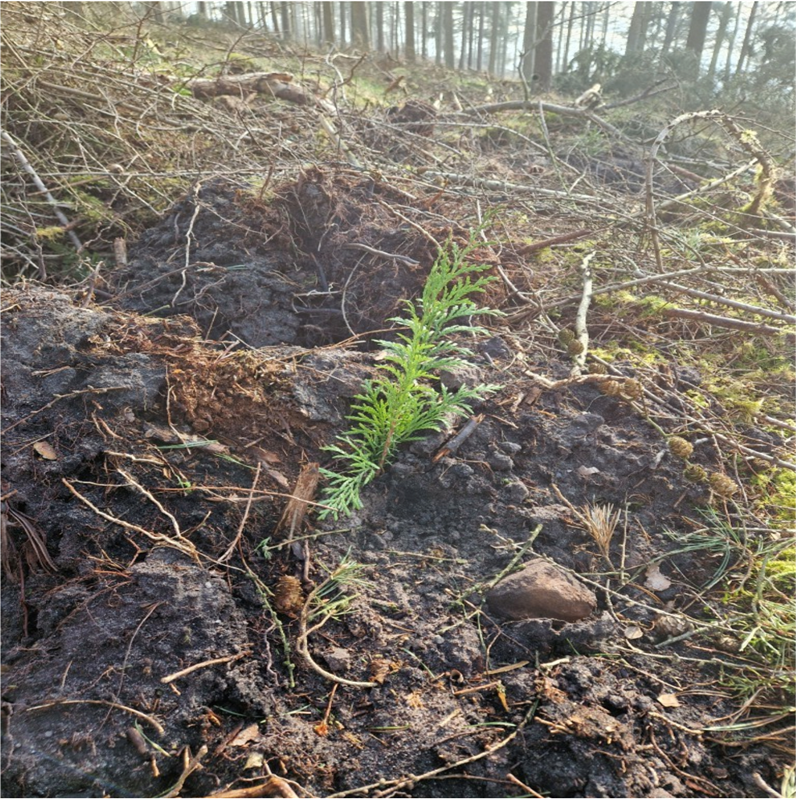
Protection and Trials
With deer management being critical to the success of the management approach taken at Scratchmill, deer management via a known contractor commenced in 2024 at the cost of £4000 per year. It is hoped that future grant funding under CS will help with this cost.
With this being the case, a deer management plan was drawn up in advance of work commencing. Intensity of management will be informed by damage assessments with a flexible approach taken to cull levels, the objective of which being to ensure minimal deer damage to planted and regenerating trees.
In addition to traditional deer management, a trial has also been undertaken to compare the use of Trico Deer Repellent, Sheep’s wool attached to the leader and non-protected trees as a control. The intention is that this trial will be monitored by dissertation students from the National School of Forestry (University of Cumbria).
Applying sheep’s wool to the leaders of trees being underplanted.
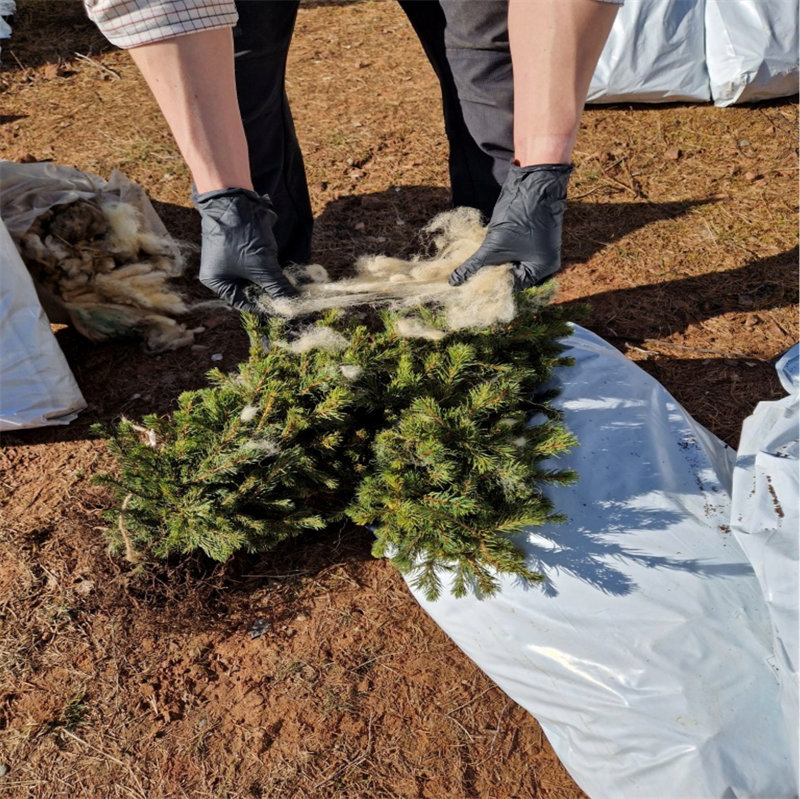

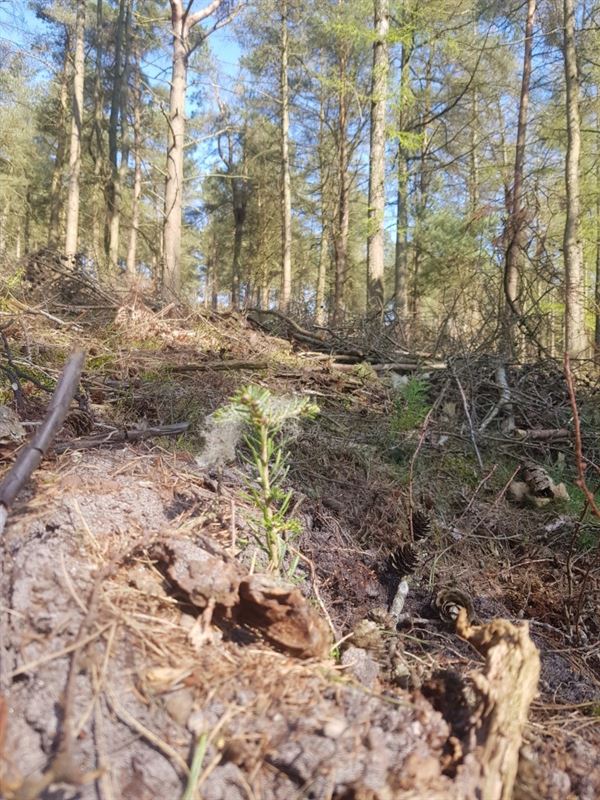
Conclusions
Scratchmill scar is in many ways a typical upland plantation, dominated by a narrow range of site-suited coniferous species with a narrow age range and in many ways not unusual.
The management plan here has opted for a lower-impact management system, and this has been and remains challenging. However, the process has been somewhat harder to implement due to regulatory requirements.
Fitting irregular silvicultural processes to a template-based Woodland Management plan is challenging where the regulatory body wants us to fix the species and management prescriptions, and the options of T / CF/ RF do not really allow this. LISS is management based on observation of the subtle changes in response to management intervention (or otherwise). The woodland management plan is a fixed point in time, and we may wish to change prescription depending on the forest development and responses to intervention and biological or other external pressures, as we have seen with climate, pest and disease and economic conditions.
During the preparation of the plans, the RPA advised that CS would be opening for applications as usual during February (2024) to apply, but the window for applications never arrived. Due to the uncertainty, the client considered conversion of the forest to non-wooded heathland, which would have meant loss of habitat for woodland-dependent priority species and an important local timber resource, which now employs local contractors and managers.
Original client forecasts were based on WD2/WS1 & WS3 and the infrastructure grant to build into the wood. The funding was not and has yet to be made available. However, the more advanced regeneration was rapidly showing a decline in apical dominance and an increase in lateral shoots, which meant delay could impact its success. The decision was taken to proceed with operations, affecting the longer-term financial forecasts.
Another impact has been that planned grey squirrel control has not been undertaken due to its financial implications, and deer control missed one season in anticipation of funding.
The implications of the withdrawal of funding meant that full implementation of the original proposals to the owner would have been delayed by at least two years. This has meant that deer numbers remained higher than anticipated and grey squirrels are now present when they were not. Road costs originally forecast for funding continue to have an impact on management decisions due to economic considerations and amended forecasts (Table 4)
Other limiting factors have been due to the locations of dreys, nests and badger setts, meaning that thinning intensity and establishment of small strips or coupes could not be established where intended and target basal areas not achieved within core target areas, leaving the thinning more uneven. Observations of the response to the stand to the uneven thinning will be a focus of future management observations.
